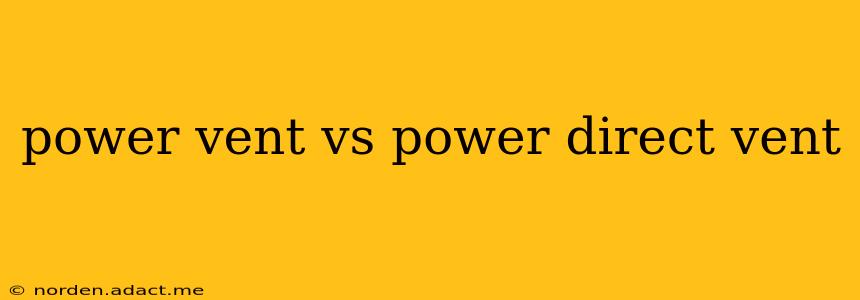Choosing the right venting system for your appliance is crucial for safety and efficiency. While both power vent and power direct vent systems exhaust combustion byproducts, they differ significantly in their design and functionality. This article will delve into the key distinctions between these two systems, helping you make an informed decision for your home.
What is a Power Vent System?
A power vent system uses a blower motor to exhaust combustion gases from appliances like furnaces, boilers, and water heaters. These systems typically vent through a single pipe, often drawing air from the surrounding area to support combustion. The exhaust gases are expelled outside the house, while the combustion process itself occurs within the home.
What is a Power Direct Vent System?
Power direct vent systems, also known as sealed combustion systems, take a different approach. They use two pipes: one to draw in outside air for combustion and another to expel the combustion byproducts. This means there’s no intake of air from inside the house. The entire combustion process is sealed off from the home's interior environment.
Power Vent vs. Power Direct Vent: Key Differences Summarized
| Feature | Power Vent | Power Direct Vent |
|---|---|---|
| Air Intake | From the room/home | From outside the home |
| Exhaust | Single pipe | Two pipes (intake & exhaust) |
| Combustion Air | Interior air | Exterior air |
| Safety | Higher risk of backdrafting in certain situations | Generally safer, lower risk of backdrafting |
| Efficiency | Can be slightly less efficient | Can be slightly more efficient |
| Installation | Typically simpler and less expensive | More complex and potentially more expensive |
What are the advantages of a power direct vent system?
Power direct vent systems offer several key advantages:
- Enhanced Safety: The sealed combustion chamber eliminates the risk of drawing in air from inside the house, mitigating the possibility of carbon monoxide backdrafting into the living space. This is a significant safety feature, especially in homes with potential air leaks.
- Improved Efficiency: While the efficiency difference might be marginal in some cases, by drawing in fresh, oxygen-rich air from outside, the system can often achieve slightly better combustion.
- Reduced Indoor Air Pollution: Because it doesn't draw air from inside, it minimizes the potential for drawing in dust, pollen, or other airborne particles that could contaminate the combustion process.
What are the advantages of a power vent system?
Power vent systems also have their benefits:
- Simpler Installation: Often easier and less expensive to install than direct vent systems, potentially leading to lower upfront costs.
- Suitable for Certain Applications: Might be more suitable for some specific appliance types or installations where a direct vent system is impractical.
Which system is better for my home?
The best venting system depends on several factors, including your home's construction, climate, appliance type, and local building codes. Consider consulting with a qualified HVAC professional to determine the most appropriate system for your specific needs. They can assess your home's characteristics and recommend the safest and most efficient option.
What are the common problems with power vent systems?
Common problems with power vent systems include:
- Backdrafting: If the system isn't properly installed or maintained, there is a risk that combustion byproducts could be drawn back into the living space.
- Reduced Efficiency: In some cases, drawing air from inside the home can slightly reduce the efficiency of combustion.
- Increased Risk of Carbon Monoxide Poisoning: Although rare with proper maintenance and installation, improper ventilation poses a significant risk of carbon monoxide poisoning.
What are the common problems with power direct vent systems?
Common problems with power direct vent systems are typically less severe and often related to installation or maintenance issues:
- Frozen Pipes: In extremely cold climates, the exhaust pipes can potentially freeze, restricting airflow and hindering operation. This is mitigated by proper installation and possibly the use of appropriately insulated pipes.
- Higher Installation Costs: Direct vent systems tend to have a higher upfront cost due to their more complex design and installation requirements.
- Pipe Length Restrictions: There are often restrictions on the maximum length of the venting pipes, which can limit installation flexibility.
Ultimately, the choice between power vent and power direct vent systems should be made in consultation with a professional HVAC technician who can assess your specific requirements and local building codes. Prioritizing safety and long-term efficiency should guide your decision.
